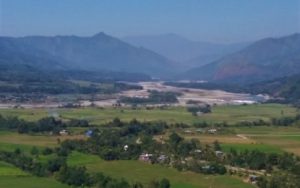By Liza Agoot/PNA

TABUK CITY, Kalinga— This province, considered as the region’s rice granary, maintains a productivity rate of over four metric tons per hectare is attributed to the farmers’ openness to adapt government recommendations, particularly the use of technologies, an official said.
Domingo Bakilan, chief provincial agriculturist, said the province has good practices, which allow it to perform well in terms of rice production.
“We have good practices which include our farmers’ adaptability to technologies introduced by the Department of Agriculture (DA) and the provincial government. They readily accept innovations because they know they will not be deceived by the government,” Bakilan told the Philippine News Agency (PNA).
Farmers in the lowland towns grow the commercial in-breed and hi-breed varieties while the province maintain the heirloom organic rice at the upland municipalities, Bakilan said.
He said the province is blessed because Tabuk valley, the original capital town and now a component city, and Rizal municipality at the lower portion of Kalinga, are endowed with fertile lands. They are the top producers of commercial rice in Kalinga.
The upland municipalities also produce organic rice or the heirloom rice which are grown on mountain slopes.
Bakilan said Kalinga is a three-time Rice Achiever awardee in 2012, 2013 and in 2017.
“Kalinga is again in the shortlist of provinces in the country for being one of the top 10 under category B of the rice achievers award with a productivity of 4.6 metric tons of palay (unhusked rice) per hectare,” he said.
Tabuk and Rizal towns that produce the hi-breed and in-breed commercial varieties averages six tons per hectare while the upland where the heirloom rice are produced maintains 2.8 tons per hectare.
The national average, he said is 4.2 metric tons.
Kalinga produced 840,000 metric tons of palay (unhusked rice) in 2017, recording a productivity rate of 4.8.
In 2017, the province produced over 700,000 MT of rice and recorded a productivity of 4.6 due to the effect of the two weather disturbances- typhoons “Ompong” and “Rosita” that hit the Cordillera region in the last part of 2018.
Bakilan said while Kalinga was hit by the typhoons, it did not affect the province’s rice production.
“Noong Ompong, vegetative stage pa lang ang pananim. Noong Rosita and Rizal harvested na at ang Tabuk harvestablena pero hindi naman masyadong nalubog kaya may na-recover pa. Noong dumating si Rosita hinog na ang palay. We were still spared (During Ompong, the plants were only in the vegetative stage. During Rosita, Rizal has finished harvesting and those in Tabuk were already ripe and ready to be harvested and because they did not go underwater, there were still lots recovered. We were still spared,” Bakilan said.
Kalinga has 37,000 hectares of land devoted to rice production contributing .2 percent to the country’s local rice production.
Abundant water
Bakilan said there are several big irrigation systems constructed by the government or called “cooperator irrigation”, aside from the communal irrigation systems constructed in the upland areas. They derive water from Chico river and its tributaries.
He said a number of communal irrigation systems were damaged by the typhoons but efforts are being exerted to allow continued rice production in upland towns.
He pointed out that while damages were incurred, they do not see Kalinga’s production dropping in 2019.
“That is a challenge for us but it will not affect the 2019 production becasue Tabuk and Rizal including lower Tanudan are where the bulk of the province’ rice production comes from and they continue to get the services of the cooperator irrigation system,” he added.
Bakilan said farmers in Kalinga are happy with their rice production as the prices of rice from the farm-gate being maintained at PHP22 a kilo for dried palay.
“Kalinga is 287 percent rice sufficient that is why we are able to sell 187 percent outside the province while we continue to eat and serve quality, aromatic rice on our tables. We can even add colored and heirloom rice in the high-quality rice that we eat,” he said.
